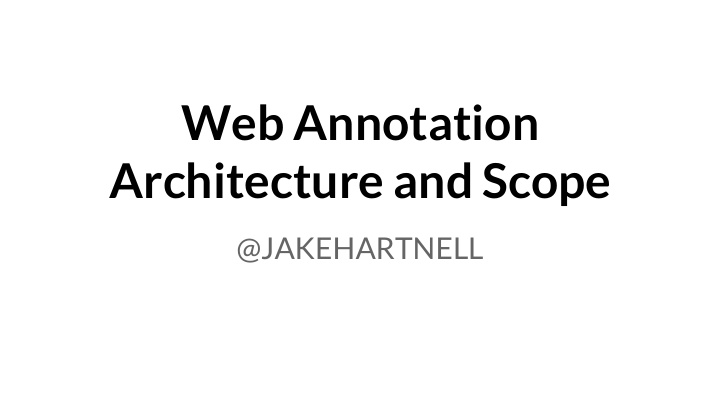



Web Annotation Architecture and Scope @JAKEHARTNELL
I love imagining the future.
“Post modern as f@#$ and genuinely cool.” ~@RansomSilver “The book really captures the confusion and social complexities of growing up online.” ~D “A full-blown 3D Technicolor dystopia.” ~L.S.E. “It’s so great to read when you’re high !” ~I School Student “A work of pure genius.” ~My sister (slightly biased) “I liked it.” ~Professor Ray Larson
Let’s imagine a future with a truly readwriteweb!
Let’s make private annotation In the browser of 2018!
A few things have changed. #understatement #peoplestillusehashtags
Web Annotation is successfully implemented in browsers and in reading applications. We can now address things not just on the granularity of a page, but of anything on that page .
What happens when you make an annotation? ● The browser captures selection information which it passes to a new html document. ● The selection appears inside this new html document as an annotation object. Perhaps an <annotation> element that contains all the necessary information for selection. ● The document must be stored somewhere.
“Channels” ● A.K.A annotation document stores. ● Each channel can have a variety of settings associated with it and offer features like groups or custom editors. ● Users control which annotation channels they subscribe to.
What is reading annotations like?
The browser loads a page
It then queries all channels the user is listening on. https://annotations.Hypothes.is https://annotations.rapgenius.com etc.
Annotation documents are loaded into a sidebar (or some other space) where they can be seen.
We can filter by channel, search annotations, and apply additional filters and sorts to find relevant documents and information.
But how do these documents connect to the page?
There is <annotation> element that gets placed into the page around selections that are referenced in documents loaded from channels. It is a type of link, its specifics are out of the scope of this talk, but it is spatial and contextual , based on where the browser is querying for annotation documents.
More goodies... We then can have different methods of visualizing , discovering , and interacting with the selections and annotation documents. Other extensions will be able to provide additional functionality. It will even be possible to search for additional documents that reference this page.
In summary Three matters the W3C should address.
1: Annotation as ‘advanced linking’ We should be able to link to any selection on a page. The browser should handle this linking/selection as well as attachment of annotations.
2: User control Give people the greatest amount of control in managing what they see. This is incredibly important for combating noise.
3: A space The browser should allow a space for these attached documents to live and be viewed, and it should be a store for personal documents/notes.
We need people to be able to link their thoughts to things.
The End @JakeHartnell jakehartnell@hypothes.is
Recommend
More recommend